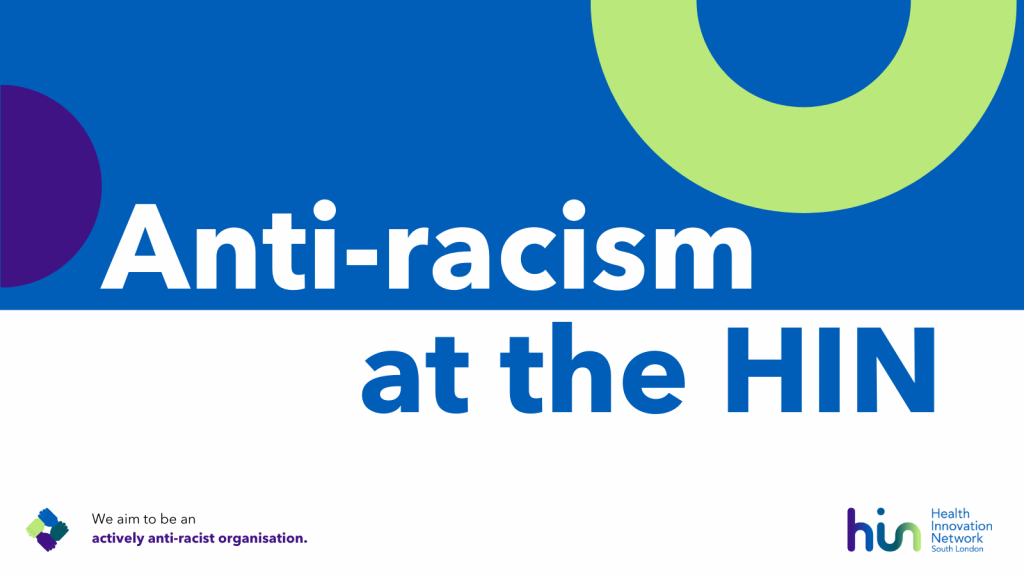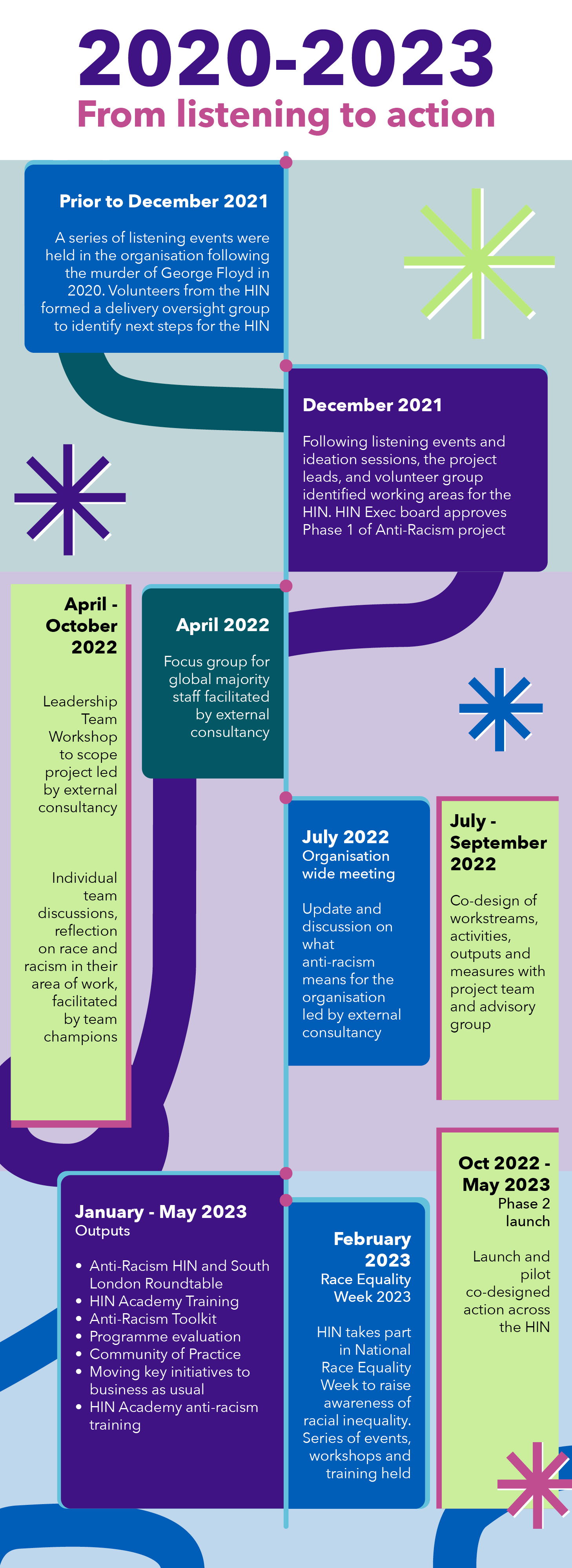HIN Anti-Racism Project Evaluation

The HIN Anti-Racism Programme took place between May 2020 and May 2023, with the aim of supporting the HIN in its goal to become an actively anti-racist organisation. In order to evaluate the effectiveness of the programme we commissioned an independent evaluation from Dr Mila Petrova and Suchismita Mohanty.
The evaluation aimed to establish:
- the overall impact of the project;
- where the project had the greatest impact;
- whether or not HIN members of staff feel more confident in talking about race and racism
- is the organisation positively impacting on:
- the experience of staff within the organisation, particularly those from Black, Asian and minority ethnic backgrounds?
- addressing race-related health inequalities through its work?
The evaluation used a qualitative approach of semi-structured interviews informed by principles of realist and episodic interviewing. In total, 21 interviews with 18 members of HIN staff were conducted between March and May 2023. Ten of the interviewees were white and eight were members of the global majority, and they reflected all hierarchical levels of the HIN, male and female staff and a variety of age groups, years of service at the HIN, teams and roles.
It was the first time I felt a sense of relief … ‘this is an organization that wants to talk about this and recognise the feelings of people from a global majority’. It's being validated. HIN Colleague
In addition to the evaluation report we have published an evidence review of workplace anti-racism interventions and impact measurements.

Evaluation Report: Key Findings
Incontestable yet not easily demonstrable change
Overall feedback ranged from solid appreciation (“important and valuable”, “a really good job”, “a very good first step”) to generous, at times effusive, praise (“fantastic”, “really excellent”, “special”, “an incredible piece of work”).
The project has had an impact on individuals working at the HIN and on some organisational processes and structures. This is the case even though the reported increase in racial and ethnic diversity of staff has been relatively small but nonetheless consistent.
Behaviours experienced as racial discrimination continue to be identified at the HIN, of a type usually considered “microaggressions” - though this language may not reflect the harm they cause. Actively anti-racist behaviours were also clearly identified yet, at times, experienced as insufficient or ineffective. Although the Chair and Chief Executive of the HIN are both members of the global majority, concerns about the leadership team continuing to be predominantly white were strong and widely shared.
Substantial impact on individual micro-actions and the organisational conversation
The most frequent types of impact this evaluation identified were cognitive, emotional and motivational impacts at an individual level which then gave rise to micro-actions in daily life.
There was unanimous agreement that the project had created “very open spaces for dialogue” and that the conversation must continue. The project has also created new language habits, a greater self-reflexivity and attention to language, and new conversations about language. Some interviewees also believed that certain very uncomfortable conversations have not yet happened.
Every interviewee reported noticeable and lasting impact of the project also in terms of actions in support of global majority individuals or as a positive assertion of one’s global majority heritage. Work aiming at structural change, particularly around recruitment, had started and achieved initial results.
The complex experience of global majority staff
The evidence of impact of the project on the experience of global majority staff does not come together into a simple overarching message.
Global majority interviewees rarely made generic comments about how their overall experience of working at the HIN had changed, though a couple reported a new sense of belonging to and pride in the organisation. All reported the project has led to learning, self-exploration and re-engagement with memories pushed at the back of the mind.
Global majority interviewees appreciated the project and trusted it was “for real”, in spite of initial hesitations and continuing experiences or concerns about racial discrimination at the HIN (though not necessarily in their team). Overall, the project has impacted the experience of global majority staff in complex ways. There is dust to settle and more work to be done before global majority staff feel that their daily experience at the HIN has clearly improved.
Partial and negative impacts, unintended consequences and potential risks
The aim of providing a safe space and the capacity to call out behaviours perceived as discriminatory was partially successful. The main blockers were a perception of lacking effective tools to challenge a superior and/or navigate the boundary between playfulness and discrimination.
The disruptive nature of the project also meant that it had unintended consequences. Most frequently discussed were the emotional discomfort and emotional exhaustion associated with the project and the degree to which some members of staff have become scared to say the wrong thing. The latter was seen as stifling discussion, learning and growth, and the project was seen as placing significant demands on staff.
Less frequently discussed were the new, at times uncomfortable, expectations of global majority staff. For instance, they could begin to feel like unwilling “gatekeeper[s] for the whole global majority”. In turn, individuals who do not identify as either “global majority” or “white” could find it difficult to locate themselves in the debate and activities.
Differences across teams
Teams differed in how the anti-racism work was integrated in their working life, and, at times, socialising with colleagues outside of work. They also differed in the degree to which global majority staff experienced instances of discrimination or felt strongly supported and valued.
Staff perceptions of next steps
Perspectives on the project moving to business-as-usual differed: from it being seen as necessary and appropriate; through it being disappointing and worrying; to appreciating the worries but placing one’s hopes in the irreversibility of the change of mindset.
Priorities for the future were to:
- “keep the conversation going” and maintain the psychological safety around the topic;
- develop and implement HR initiatives, such as around recruitment, promotion, mentoring, upskilling people, and developing pathways for apprenticeships or internships; and,
- broaden the scope of the work in several directions, most often in terms of increasing the variety of ethnicities and cultures in the spotlight.
Sustaining the impact
Individuals who have experienced an inner transformation in becoming more anti-racist are highly likely to continue to be anti-racist in their individual-level actions. It is less certain if they would have the capacity to work towards modifying processes and structures that embody racial discrimination. Staff turnover may also result in weakening of this internal capacity.
At present, the HIN is at a natural juncture to collect quantitative baseline data from across the organisation to help assess this and, potentially, to set up “natural experiments” which its team structure provides.
It remains to be seen whether the HIN and the pioneers and supporters of its Anti-Racism Project have not just shown the faith to start a courageous walk, but also the perseverance to persist and engage others on a long road. Most likely, this long road is one which none of us will see walked fully in our lifetime but more and more of us – white, global majority and numerous “other-ed” within and between those groups – are called to commit to.